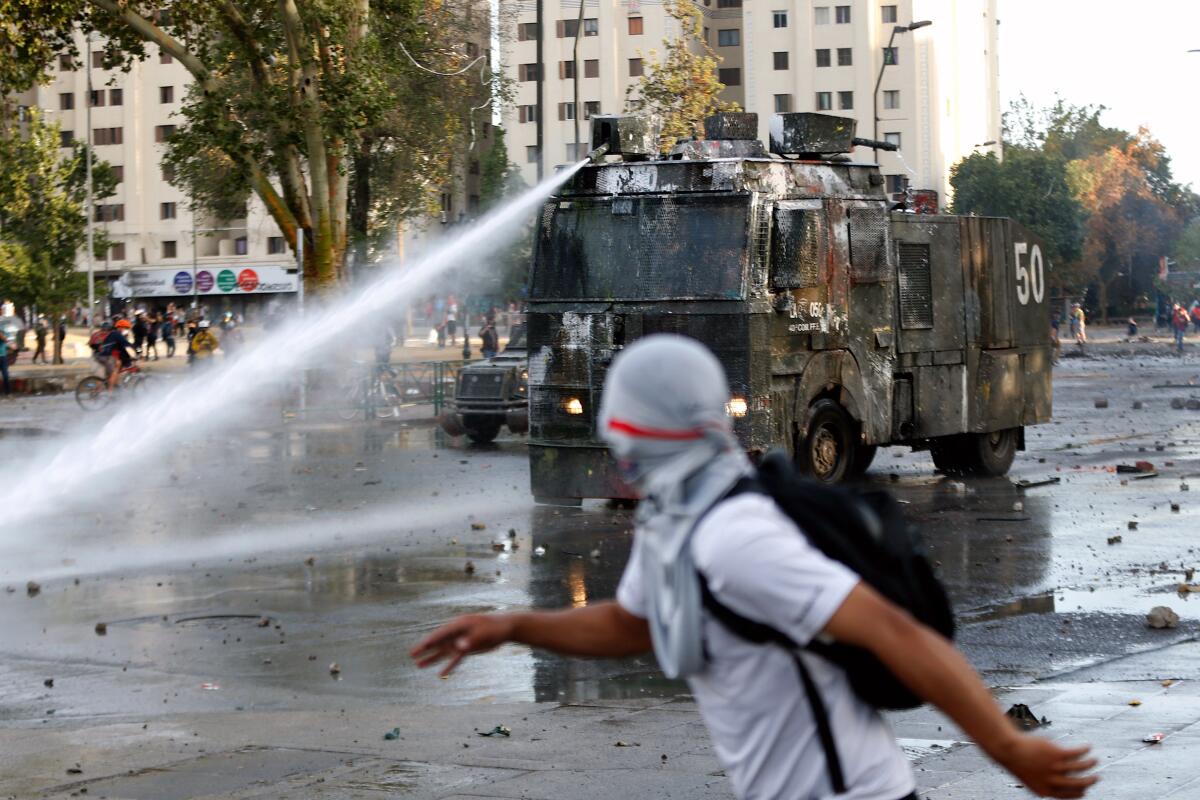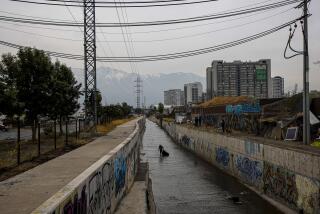For many Chileans, U.S. demonstrations spark reminders of impassioned Chile protests

- Share via
SANTIAGO, Chile — Tens of thousands took to the streets demanding justice and were met by heavily armed police and soldiers, with images of blood-spattered protesters going viral.
“I can’t see!” emerged as a slogan among demonstrators, who said police targeted their eyes with tear-gas projectiles and rubber bullets.
The images are similar to some that have played out in recent weeks across the United States following the death of George Floyd in Minneapolis at the hands of police.
But this unrest occurred last year in Chile, where many here see parallels between the ongoing U.S. turmoil and months of civil disturbance that largely paralyzed the South American nation of 19 million.
The Chilean movement also went global, generating solidarity actions abroad backing expanded democracy and indigenous empowerment and denouncing violence against women.
“It all felt too familiar,” said Juan Pablo Cortés, 42, who is among many here likening the U.S. and Chilean scenarios. “We were in the midst of a similar uprising like the one in the United States when the pandemic outbreak put everything on hold.”
Protests were building anew in Chile this year in advance of a planned national constitutional referendum when the coronavirus hit, plunging the country into intermittent shutdown.
Cortés, an illustrator, recently penned a sketch now circulating on social media that depicts Floyd alongside Camilo Catrillanca, a 24-year-old indigenous Mapuche man fatally shot by Chilean police in 2018.
In Chile, though, it was a 3.7% transit fare hike in Santiago, the capital, that triggered last year’s protests, rather than an incident of police violence or racism.
The fare increase prompted infuriated students already facing financial hardships to launch a social-media campaign in mid-October urging commuters to jump subway turnstiles.
That morphed rapidly into broad demands for social reform in a nation long hailed as a Latin American oasis of economic progress and political stability — but a country where half of all workers earn the equivalent of $500 a month or less.
“The students got fed up with seeing their parents pay more and more for transportation, food and health[care],” said Catalina Salazar, 26, a nursing student and former protester in the working-class neighborhood of Macul in southeastern Santiago. “And the government only began paying attention when people started looting and things got out of hand.”
On Oct. 19, Chilean President Sebastián Piñera declared a curfew in the capital, a lockdown that soon expanded to other cities in an unprecedented move at a time of democratic governance. Images of soldiers in the streets evoked dark memories of the military junta of Gen. Augusto Pinochet, which ruled from 1973 to 1990.
Like President Trump, Piñera signaled a hard line as violence and property damage mounted amid daily battles between protesters and police backed by soldiers.
“We are at war against a powerful enemy, who is willing to use violence without any limits,” Piñera, a conservative billionaire businessman, declared on Oct. 20.
Five days later, more than 1.2 million people rallied peacefully on the streets of Santiago, rejecting the president’s martial characterization of the street actions.
At least 31 civilians died in the Chilean protests, which continued through 2019, authorities say, mostly perishing in shooting incidents or fires, or after being struck by vehicles amid the mayhem.
Federal prosecutors say investigations continue into all 31 deaths, which included the apparent suicides of two protesters in police custody. At least 38 police and military personnel have been charged with brutality and other crimes, prosecutors say, while Chilean police commanders say they have fired 14 officers (known here as carabineros) and disciplined 83 others.
Chile’s National Institute of Human Rights said that almost 4,000 civilians were injured, including 460 who suffered eye injuries—the latter triggering charges that police intentionally sought to blind protesters, an allegation denied by authorities.
After Floyd’s death, Chilean filmmaker Sebastián Lelio — director of the Oscar-winning “A Fantastic Woman” — posted a montage online of U.S. and Chilean flags with the words, “I can’t breathe … I can’t see” penned in English and Spanish.
Property damage in Chile was estimated at $1.4 billion as looters ransacked shopping malls, supermarkets and pharmacies and vandalized more than 100 metro stations, including seven that were burned to the ground. More than 2,400 Chilean police were injured, authorities said, including 65 with bullet wounds and 85 with broken bones.
Although not directly related to race, the Chilean protests featured a strong subtext championing the country’s indigenous Mapuche minority, whose members say they suffer from discrimination and police repression.
“Everything here has to do with inequality, which can be shown openly through racism or more secretly through [issues of] class,” said Cortés, the Chilean illustrator.
As in the Floyd protests in the United States and Europe, Chilean demonstrators targeted historic statues. Protesters destroyed or defaced more than 300 public monuments, many of them depicting Spanish conquistadors, often planting in their place the Mapuche flag — blue, green and red, with a traditional drum (kultrun) in the middle.
The Chilean protests also galvanized global movements denouncing violence against women.
In the midst of the turmoil here, a feminist art collective called Las Tesis, from the port city of Valparaíso, staged a choreographed street performance titled “A Rapist in Your Path.” Videos of the performance spiked on social media, and soon the performance was being replicated throughout Latin America, Europe, Asia and elsewhere.
Last December, a group of more than 200 women performed the piece in front of the Los Angeles County Museum of Art.
As in the United States, the jury is still out on whether Chile’s civil uprising will yield fundamental reform.
Authorities jettisoned the planned transit-fare hikes days after protests erupted. But sweepings demands for a more equitable society were left for later. The government’s major concession was a nationwide referendum set for April 26 on whether to rewrite the nation’s Pinochet-era Constitution.
Coronavirus pushed back the date until Oct. 25. Many here fear further delays or diluted constitutional reform as Chileans’ focus shifts to emerging from the health crisis — Chile has recorded almost 170,000 coronavirus cases and at least 3,100 deaths — and rebuilding the pandemic-shattered economy.
Salazar, the nursing student who was among last year’s masked protesters confronting police and soldiers, can be found these days checking passengers’ temperatures at a bus terminal in the capital. “Now,’ Salazar says, “ I’m at the front line of the health emergency.”
Special correspondent Poblete reported from Santiago and staff writer McDonnell from Mexico City.
More to Read
Sign up for Essential California
The most important California stories and recommendations in your inbox every morning.
You may occasionally receive promotional content from the Los Angeles Times.










